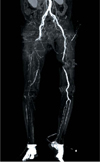Abstract
As the elderly population increases, occurrence of hip fractures has shown a rapid increase, and posttraumatic and postoperative venous thromboembolism can lead to fatal complications. Current prophylactic management includes mechanical and chemical prophylaxis. A 76-year-oldfemale, who was lost to follow-up after diagnosis of pulmonary thromboembolism four years ago, was admitted to our emergency room for a right intertrochanteric fracture. Before the operation, the thromboembolism recurred and was treated with anticoagulation medication. Bipolar hemiarthroplasty and fixation of the greater trochanter with a hook plate were performed 18 days after the trauma. Superficial femoral artery obstruction and venous thromboembolism occurred on the first day after the operation.
Figures and Tables
Fig. 1
(A) Pelvis A-P view x-ray shows AO type A3 reverse obliquity femur intertrochanteric fracture. (B) Hip axial view x-ray shows AO type A3 reverse obliquity femur intertrochanteric fracture.

References
1. Cha SI, Lee SY, Kim CH, et al. Venous thromboembolism in Korean patients undergoing major orthopedic surgery: a prospective observational study using computed tomographic (CT) pulmonary angiography and indirect CT venography. J Korean Med Sci. 2010; 25:28–34.

2. Piovella F, Wang CJ, Lu H, et al. Deep-vein thrombosis rates after major orthopedic surgery in Asia. An epidemiological study based on postoperative screening with centrally adjudicated bilateral venography. J Thromb Haemost. 2005; 3:2664–2670.

3. Lee HY, Koh SH, OH SM, Park HC. Deep vein thrombosis after total hip arthroplasty: the incidence of DVT and Correlation between DVT and risk factors. J Korean Soc Vasc Surg. 2005; 21:40–44.
5. Rosencher N, Vielpeau C, Emmerich J, Fagnani F, Samama CM. Venous thromboembolism and mortality after hip fracture surgery: the ESCORTE study. J Thromb Haemost. 2005; 3:2006–2014.

6. Heit JA, Silverstein MD, Mohr DN, Petterson TM, O'Fallon M, Melton LJ 3rd. Risk factors for deep vein thrombosis and pulmonary embolism: a population-based case-control study. Arch Intern Med. 2000; 160:809–815.

7. American Academy of Orthopaedic Surgeons (AAOS). American Academy of Orthopaedic Surgeons clinical guideline on prevention of symptomatic pulmonary embolism in patients undergoing total hip or knee arthroplasty page [Internet]. Rosemont (IL): AAOS;2011. cited 2012 Feb 12. Available from:http://www.aaos.org/research/guidelines/VTE/VTE_guideline.asp.
8. Whitesides TE, Heckman MM. Acute compartment syndrome: Update on diagnosis and treatment. J Am Acad Orthop Surg. 1996; 4:209–218.

9. Kearon C, Kahn SR, Agnelli G, et al. Antithrombic therapy for venous thromboembolic disease: American College of Chest Physicians Evidence-Based Clinical Practice Guidelines (8th Edition). Chest. 2008; 133:454S–545S.




 PDF
PDF ePub
ePub Citation
Citation Print
Print





 XML Download
XML Download